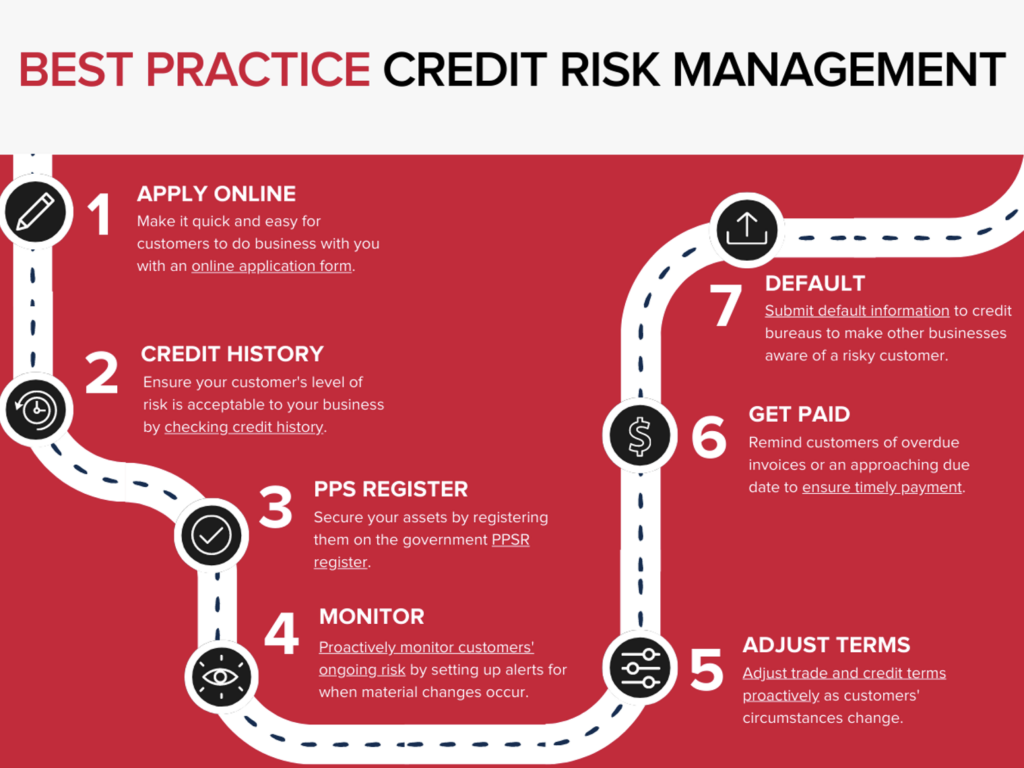Whether you’re a long-time credit controller, a new business owner or a seasoned finance manager, a clear, consistent credit risk management process is key to doing more business, with the right customers, and getting paid faster.
An effective, well-designed credit risk management process will save you time, deliver your customers a better experience, increase employee satisfaction, support compliance with government regulations, protect your assets and help secure your cash flow. In a nutshell, with an efficient credit risk management process you can do away with the ambulances at the bottom of the credit cliff. Any issues should be quickly identified as they crop up, giving you the opportunity to proactively manage your risk exposure.
So, you’re sold on building a proper credit risk management process, but unsure of what one actually looks like. Underpinning an ideal credit risk management process is exactly that – a process. Map out all the steps a customer takes as they journey through your purchasing process. From everything they must do to become a customer, to the steps you take to collect repayment for the goods or services provided. Once you’ve written them all down, you should be able to group them into the following overarching customer relationship stages:
- Onboarding
- Account management
- Receivables

The goal of the onboarding stage of the journey is to ensure you start your relationship with customers with eyes wide open and having completed a thorough risk assessment. This stage is where you gather all the decision-making information you need to onboard them as a customer, complete a credit assessment and do due diligence checks. And, if successful, set the tone for the relationship going forward with appropriate credit terms.
This is also a key area impacting customer experience – fast, easy onboarding can make all the difference in creating the right tone for a productive, respectful relationship. Key onboarding steps include:
- Gathering customer information for credit applications
- Identity verification
- Credit history checking
- Reviewing payment default data
- PPSR check and registration
Account management is like your ongoing homework. You’ve moved past the new customer honeymoon period and now your sales and marketing team are likely working hard to keep them engaged and making repeat purchases.
This is the time where a strong credit risk management process comes into its own. Being proactive is the difference between a credit team that ticks the boxes and one that is gold standard. Proactive monitoring of your customers so you’re aware of real-time changes in a customer’s creditworthiness or risk of default can have a significant impact on profitability and getting paid. Being agile here and acting on real-time knowledge is crucial – when a customer’s credit score changes, their credit limits or your credit policy should adjust with this. Core steps on your checklist here should include:
- Routine credit rating monitoring
- Setting up automated rules to be alerted when a customer’s risk profile changes
- Regular health checks of your credit portfolio
- Mitigating risk by amending credit terms as required
Crunch time. If all has gone well, then the accounts receivable stage of the journey should be transactional – job completed, invoice sent, payment received. Unfortunately, for a variety of reasons this is often not the case.
However, strong credit risk management can go a long way to smoothing this part of the journey for both businesses and customers and ensure payment is collected in a timely manner. Building in automation to this part of the process can save you valuable time. Cash flow can be better protected with easy debtor prioritisation based on real-time debtor risk and trade payment insights. An ideal credit risk management process should include:
- An automated accounts receivable management system
- Debtor risk insights
- Trade payment insight
- Templated, consistent collections communications
There are clear signs that you have built, and are running, an effective credit risk management process:
ONE: Fast, easy onboarding
Having a good process will speed up new customer set-up. Doing business with you will be easy for customers using an online application form. And, with all the customer information you need to hand every time, you’ll complete due diligence faster. Customer credit decisions will be equally quick and easy, with your tools doing the hard work, making credit recommendations to you based on criteria you’ve previously set.
TWO: Real-time creditworthiness monitoring
A robust process will have automation baked in. Real-time alerts will let you know if a customer’s potential risks or probability of default has changed, or if an adverse event has been logged against them. Taking it one step further, the true value of this stage of the process is action. With real-time credit risk knowledge to hand, your credit terms will be adjusted as required to mitigate risk more effectively.
THREE: Minimal manual accounts receivables tasks
No sticky notes reminding you to call a customer on a particular date. A well designed, effective credit risk management process will reduce the amount of manual receivables tasks you are burdened with. Automation tools that form the foundation of your process will prioritise who you need to chase day to day. They’ll remove the juggle between systems with all financial information, customer contact information and communications history in one place. Chasing customers should be faster and only those extremely tricky debtors should require human intervention. Bottom-line, you’ll be getting paid faster.
If you’ve read through this and have a few lingering questions about your own credit risk management process, now is the time to act. Not sure where to start? Map your current process out. Identify the area that causes the most internal pain or is particularly hard for customers to navigate.
Some questions to ask yourself are:
- Do you use the PPS register?
- Can you quickly and accurately register assets on the PPS register?
- Are your customer application forms digital or paper?
- Have customers raised concerns or frustration with the steps they must complete to start trading with you?
- Are you automatically alerted to changes in customers’ financial situations?
- Do you have a consistent, automated accounts receivable process?
- Is chasing payment a series of time-consuming, manual tasks for you?
If your process is non-existent, or improving your current one is just too overwhelming, get in touch with one of our team. We’ll sit down with you to review how things are currently working, where improvements could be made and identify the best place to start.

Get started with CreditorWatch today
Take your credit management to the next level with a 14-day free trial.

